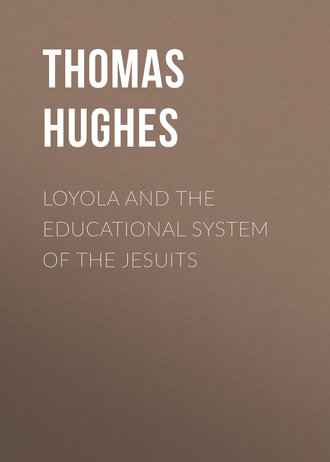 полная версия
полная версияLoyola and the Educational System of the Jesuits
What this means, with regard to its strategic value, there is no need of our being told. The Duke of Parma, writing, in 1580, from the seat of war in the Netherlands to Philip II of Spain, said: "Your Majesty desired that I should build a citadel in Maestricht; I thought that a college of the Jesuits would be a fortress more likely to protect the inhabitants against the enemies of the Altar and the Throne. I have built it."46
Sixty years later, after the long generalship of Aquaviva, who during 34 years governed the Order with the ability of another Ignatius, the number of colleges was 372. Well might his immediate successor, Mutius Vitelleschi, writing to the whole Society about the Education of Youth, speak of the "beautiful and precious mass of gold, which we have in our hands to form and finish."47
One hundred and fifty years after the death of Ignatius, the collegiate and university houses of education numbered 769. Two hundred years after the same date, when the Order was on the verge of universal suppression, under the action of University men, Parliamentarians, Jansenists, Philosophers, and of that new movement which was preparing the Revolution, the Jesuit educational institutions stood at the figure, 728. The colleges covered almost the whole world, distributed into 39 Provinces, besides 172 Missions in the less organized regions of the globe.48
If we look at these 700 institutions of secondary and superior education, under the aspect of their constitution, that is to say, of their scope, their system, the supreme legislative and executive power which characterized them, we find that they were not so much a plurality of institutions, as a single one. Take the 92 colleges of France alone.49 In one sense, these may be considered as less united than the 50 colleges of the Paris University, for the Paris University was in one quarter of a city, which offers a material unity; these, on the contrary, were spread over the whole of France, presenting the characteristics of "national" education; just as the 700 were over the whole world, a cosmopolitan system. But, regarded in their formal and essential bond, they were vastly more of a unit, as an identical educational power, than any faculty existing. No faculty, whether at Paris or Salamanca, Rome or Oxford, ever possessed that control over its 50, 20, or even 8 colleges, which each Provincial Superior exercised over his 10, 20, or 30, and the General over more than 700, with 22,126 members in the Order. In the one General lay the power of an active headship; from him the facultative power of conferring degrees emanated; and he had one system of studies and discipline in his charge to administer, with a latitude of discretion according to times, places, and circumstances.
As to the numbers of students, and the general estimate to be formed of them, I will record such data as fall under the eye, while passing rapidly over the literature of the subject.
In Rome, the 20 colleges attending the classes of the Roman College numbered, in 1584, 2108 students. Father Argento, in his apology to the States at Klausenburg, in 1607, mentions that the schools in Transylvania were frequented by the flower of the nobility; and, in his "History of the Affairs in Poland," dedicated to Sigismund III, he attests that from 8000 to 10,000 youths, chiefly of the nobility and gentry, frequented the gymnasia of the Order in Poland. At Rouen, in France, there were regularly 2000. At La Flèche there were 1700 during a century; 300 being boarders, the other 1400 finding accommodation in the village, but always remaining under the supervision of the faculty. Throughout the seventeenth century, the numbers at the College of Louis-le-Grand, in Paris, varied between 2000, 1827, and 3000; including, in the latter number, 550 boarders. In 1627, only a few years after the restoration of the Society by Henri IV, the one Province of Paris had, in its 14 colleges, 13,195 students; which would give an average of nearly 1000 to a college. Cologne almost began with 800 students, – its roll in 1558. Dilingen in 1607 had 760; in its convictus, 110 of the boarders were Religious, besides other Ecclesiastics; the next year, out of 250 convictores or boarders, 118 were Religious of various Orders, the secular Priesthood being represented among the students generally. At Utrecht, during the first century of the Order's existence, there were 1000 scholars; at Antwerp and Brussels each, 600; in most of the Belgian colleges, 300. As to Spain and Italy, which first saw the Society rise in their midst, and expand with immense vigor all over them, I consider it superfluous to dwell particularly upon them.
In many of the capitals and important centres throughout Europe, there were separate colleges for nobles. Elsewhere the nobility were mixed with the rest; thus 400 nobles and more were attending the Jesuit schools in Paris. It was studiously aimed at by the Order to eliminate, in matters of education, all distinguishing marks or privileges. Thus Father Buys endeavors, in 1610, to reduce the practice at Dilingen to the custom of the other colleges in the upper German Province.50
Most of the Papal Seminaries founded by Gregory XIII, at Vienna, Dilingen, Fulda, Prague, Gratz, Olmütz, Wilna, as well as in Japan and other countries, were put under the direction of the Society; as Pius IV did with his Roman Seminary; and St. Charles Borromeo with that of Milan.
Not knowing what the absolute average really was in these 700 institutions, we may still form some idea of what the sum total of students must have been at its lowest figure. For this purpose, we can take an average which seems about the lowest possible. I have not met with any distinct mention of a college having less than 300 scholars. There are indeed frequent complaints in the general assemblies, regarding what are denounced as "small" colleges. However, it seems clear from numerous indications, as, for instance, from the Encyclical letter of the General Paul Oliva,51 that these colleges were called small, not primarily on account of an insufficient number of students, but because of insufficient foundations, which did not support the Professors actually employed. A document for the Rectors notes that "thus far almost all the colleges, even such as have received endowments, suffer want regularly, and have frequently to borrow money."52
Hence we may be allowed to take, as a tentative average, 300 students to a college. At once, we rise to a sum total of more than 200,000 students in these collegiate and university grades, all being formed at a given date under one system of studies and of government, intellectual and moral.
If statistics, in that nicely tabulated form which delights modern bureaus, have failed us as we run over the whole world to decipher the indications, there is yet another view which we may catch of the same subject, and one that is equally valuable. It is the multitude of nations into which this educational growth ramified. At Goa, in Hindustan, the seminary, which was inferior to none in Europe, had for its students, Brahmins, Persians, Arabians, Ethiopians, Armenians, Chaldeans, Malabari, Cananorii, Guzarates, Dacanii, and others from the countries beyond the Ganges. Japan had its colleges at Funai, Arima, Anzuchzana, and Nangasaki. China had a college at Macao; and later on many more, reaching into the interior, where the Fathers became the highest mandarins in the service of the Emperor, and built his observatory. Towards the close of the eighteenth century a large number of colleges were flourishing in Central and South America. All of these disappeared, when the Order was suppressed. The youth, who could afford to obtain the education needed, went over to Europe, whence they returned, a generation quite different from what had been known of before. They returned with the principles of the Revolution. And the whole history of Central and South America has changed, from that date onwards, into a series of revolutions, which are the standing marvel of political scientists to our day.
To consult a graphic representation of how this educational Order looked on the map of the world, one may glance into the ninth volume of the Monumenta Germaniæ Pædagogica. There Father Pachtler, as in his other volumes of the series, sketches only the German "Assistency" of the Society of Jesus. The five Assistencies of the Order served the purposes of government, by grouping many Provinces together into larger divisions. In 1725, the German Assistency comprised nine out of thirty-two Provinces. The nine in question are those of Flandro-Belgium, French Belgium, the Lower Rhine, the Upper Rhine, Upper Germany, Bohemia, Austria, Poland, Lithuania. The map at the end of Father Pachtler's volume represents all this country, with the towns marked differently, according as they contained either universities of the Order, or colleges, or convictus, that is, boarding-colleges, or seminaries, or residences. The chronological order of their rise is presented in a table at the beginning of the same volume, with a note to indicate more in particular the grade or amplitude of each, as being a Studium Generale, otherwise called University or Academy, a College or a Gymnasium, as well as the annexes of each, in the shape of one or more convictus, one or more Episcopal or Papal Seminaries, a college of nobles, a convictus for poor scholars. By means of this map, a graphic presentation is afforded of one Assistency, from which, by a proper extension, the whole world may be portrayed to the imagination. In 1750, within the limits of this map, there were 217 colleges, 55 seminaries, 73 residences, 24 novitiates, 160 missions, 6 professed houses.53
The universities here spoken of, otherwise called Studia Generalia, or Academies, are quite typical, a special Jesuit development of the mediæval style. An exact and official form, drawn up for the University of Gratz, may be found in the same Monumenta.54 As Father Pachtler remarks, it shows at a glance the inner working of a Jesuit university, and the general system prevailing over the whole Society. He entitles the document: "Ordnung einer ausschlieschlich von Jesuiten geleiteten Universität," or "Einer selbständige Universität, 1658." The Latin title is: "Forma et Ratio Gubernandi Academias et Studia Generalia S. J." It was the compilation of Father John Argento.
Upon this basis of the amount of work done, as well as its intrinsic character, shown by the results, I was going to draw some inferences with regard to the amount of the temporal endowments, which must have been required to support such a vast organization, and must have been vested in the Order by the Christian world. One might compare the work done with what Oxford accomplishes; and, seeing that the latter university supplies the facilities for higher education, and that far from gratuitously, to only a couple of thousands among the nobility and gentry, then, since it spends upon this an annual revenue of $2,500,000, how much would be required to conduct the education of a quarter of a million of students? Our arithmetic would feel oppressed by the calculation.
But the calculation is not necessary. It is quite evident that religious poverty gave the key to the situation, – poverty, self-abnegation, the resignation of all temporal considerations in life, by men who had no families to provide for, no station to acquire; who had themselves given up every station, from that of the clerical benefice, or the liberal and martial careers, to ducal coronets, princedoms, and even royalty; men therefore, who were bestowing with themselves, and in themselves, the essential endowment of education upon the world, and who needed only to have that supplemented with the few temporal necessities still remaining. And the conclusion to be drawn seems to be this. The Christian world, whether ruler or people, republic or municipality, was making a safe and lucrative investment, whether at home or abroad, in the midst of civilization or of barbarism, when it consigned the absolute use of sufficient temporalities to a world-wide faculty, inspired by the sentiment of religious devotion.
For what is the object of any religious society whatsoever? It is to complete in each of its members the duties of the man, the citizen and the Christian, with other duties called "religious," which, correlative with the former, are nevertheless distinct from them. They are duties which presuppose the moral virtues, the civil and Christian virtues, and tend to complete them with the highest qualities to which perfect Christianity aspires, those of self-devotion and religious self-consecration.
Hence the experiences, making a drama and a tragedy, when the Society abruptly disappeared. Supposing even that enough of competent men, with all personal requirements, could have been found to fill the void, what of their salaries and support? Take an instance. The revenues, which at Bourges had been enough for the support of thirty Jesuits, were found, after the Suppression of the Order, not to afford an adequate compensation for ten secular Professors.55 Frederic II of Prussia, sending an agent to negotiate with Pius VI about retaining the Order in his States, expresses himself thus in a letter to Voltaire: "The surest means (to perpetuate a series of Professors) is to preserve a seminary of men destined to teach. In studying the sciences, they fit themselves for the office of instructing. It would be no easy task to fill instantaneously a vacancy left by a skilful professor. If the education of ordinary citizens be necessary, the training up of instructors must be no less so." And then, coming to the point before us, the King continues: "Besides, there are reasons of economy for preferring such a body of men to mere secular individuals. The professor taken from the latter class will cost more, because he has a greater number of wants. It is needless to remark that the property of the Jesuits would not be sufficient to remunerate their successors; and that revenues, which pass over to the administration of the government, always suffer diminution."56 Speaking of Ganganelli, Pope Clement XIII, who was under pressure from various quarters to make him suppress the Order, Frederic writes to Voltaire in 1770: "For my own part, I have no reason to complain of him; he leaves me my dear Jesuits, whom they are persecuting everywhere. I will save the precious seed, to give some of it, one day, to those who should wish to cultivate a plant so rare."57
The testimony of documents is uniform upon the poverty of these men, whom Protestant historians like Grotius, Robertson, and others marvel at, for the authority they possessed in the world, for the purity of their lives, their success in teaching, and their art of commanding with wisdom as they themselves obeyed with fidelity. Their life was one of straitened circumstances and self-abnegation. We may see it illustrated in Dilingen.58 Or again, at the great royal college, founded by Henri IV at La Flèche, where three hundred boarders were supposed to be paying their own expenses, as pensionnaires, we find Louis XIII issuing a royal decree that his magistrates are to prosecute "les rétardataires et les récalcitrants par toutes les voyes raisonnables," persons who did not pay the expenses of their own children, but left that interesting occupation to the college. With all that, says Rochemonteix, nothing came of it, neither of the royal injunctions, nor of judicial suits; things went on the same way, "the parents paying badly, and the treasurers lamenting."59
I will close this chapter with one case, because it serves to emphasize a particular sequel of the Suppression; that is, the revival of a tuition-fee. A recent author, writing in 1890, tells the history of the College of Saint-Yves at Vannes, in Brittany. He sums up its revenues at 6000 livres. Placed in the hands of the Order, this college, in 1636, that is, seven years after the Society had assumed charge, directed 400 students; later on, 900; and then 1200. In 1762, the faculty consisted of thirteen members, besides the four Fathers engaged in the adjoining house of retreats. All rendered various services, as is usual in a college of Jesuit instructors. To these we must add the requisite complement of the faculty, at least half as many more lay assistants, belonging to the Order, and to the same local community. Here then are twenty-two at the least, subsisting on 6000 livres a year; and meanwhile providing their house, their library, their physical cabinet, which was fully fitted up with all necessary instruments, and their observatory.60 "The moment after the Suppression," he goes on to say, "it was quite another affair! Ten secular professors cost 11,000 livres for their salaries alone!" The author gives the list of their salaries. "To reëstablish equilibrium, one of the first acts of the parliament was to exact from each scholar a tuition-fee of twelve livres; and yet they complained, they could not make ends meet."
Observe, a tuition-fee! On the day after the Suppression, they begin to undo the very work, which, two hundred and thirty years before, the Order had begun to do at its birth, spreading education gratuitously, without drawing on pupils, or drawing on the public treasury.
Well might the General Vincent Caraffa say, in the time of the Thirty Years' War, "We abound rather in men than in revenues." And he says so, in the same breath and in the same sentence, in which he is asking Priests to offer themselves for life to the work of teaching the lower branches, a work which he calls laborious, in times which he specifies as disastrous, and in circumstances which he describes as having no provision made for the means of living.61
This brief sketch will go to show how the Christian world did, indeed, meet the proposal of the Order, and found seven hundred colleges. But it also shows how the Order endowed the world, and had even to make good, with its personal heroism, the defects in many of the foundations.
CHAPTER VI
THE INTELLECTUAL SCOPE AND METHOD PROPOSED
As the second part of this book is intended to be a pedagogic analysis of the mental culture imparted, I need not sketch here, save in a general way, the intellectual scope proposed by Ignatius of Loyola, and the method which he originated. Both scope and method vary somewhat, according as the students contemplated are respectively external to the Order, or members of it. The latter are to be qualified for becoming future Professors, even though, in point of fact, only a certain proportion of them become so.
Studious youth in general, including Ecclesiastics and Religious of the various Orders, are considered by Ignatius as distributed amid two kinds of educational institutions. One of these he calls the Public School; the other, a University. The first is that which extends, in its courses, from the rudiments of literature up to the lower level of university education. He says: "Where it can conveniently be done, let Public Schools be opened, at least in the departments of Humane Letters."62 In a note, he explains that Moral Theology may be treated in a gymnasium of this kind. Father Aquaviva, in 1588, puts this kind of school down as the lowest of three ranks of colleges; and sums up the courses as being those of Grammar, Humanities, Rhetoric, Languages, and Moral Theology.63 He also explains why the lowest Jesuit curriculum must fill these requirements, "in order that the Society be not defrauded of the end it has in view, which is, to carry the students on at least as far as mediocrity in learning, so that they may go forth into their respective vocations, Ecclesiastics to their ministry, lay students to their own work in life, qualified in some degree with a sufficiency of literary culture."64 This curriculum served also the purpose of those, who, while members of the Order, were for some reason dispensed from the full course of studies.65 If any grades are wanting in a college, it must be the lower ones which are omitted, the higher being retained.66 Ignatius goes on to limit the courses in a gymnasium of this kind: "Let not higher sciences be treated here; but, to pursue them, the students who have made due progress in literature are to be sent from these colleges to the universities.67
Passing on to universities of the Order, he defines for their scope, first, in behalf of those who are to be Ecclesiastics, Scholastic Theology, Holy Scripture, and Positive Theology; secondly, for all students, Humane Letters, Latin, Greek, Hebrew, and other such languages as Chaldaic, Arabic, and Indian, subject to the demands of necessity or utility; moreover, Logic, Physics, Metaphysics, Moral Philosophy, and Mathematics. All these departments are to be provided for by Professors of the Order. If the departments of Civil Law and Medicine are added, they will be conducted by Professors not of the Society.68
As to the Scholastic members of the Society, their mental culture in the Order begins, of course, where their collegiate curriculum had closed, that is, at the end of their classical course. Their studies henceforth are defined by two objects; one, that of professing, as formed Jesuits in the future, what they are studying now; the other, that of being differentiated, according to talent and circumstance, into preachers, writers, directors of consciences, or managers of affairs.
In view of this two-fold object, all the examinations, arranged for members of the Order in the advanced courses, are regulated by one standard, that the Jesuit Scholastics must be found competent, at each stage, to teach the course in which they are being tested. Accordingly, they review their previous literary acquirements, in all the lines which the Society regularly professes; then, during three years, they apply exclusively to Philosophy and Natural Sciences; and, four years more, to Divinity and allied Sciences.69
This protracted course, therefore, as given more in detail by the subsequent Ratio, consists of Poetry, Rhetoric, and Literature; Mathematics, Physics, and Chemistry; Logic, Ontology, Cosmology, Psychology, and Natural Theology; Ethics, Natural, Social and Public Right, Moral Theology, Canon Law, Ecclesiastical History, Scholastic Theology, Hebrew, Sacred Scripture. The courses are to be pursued either in the same classes which external students attend, or, in their own university classes, when a general house of studies is formed as a "Scholasticate." In both cases, they have Seminary exercises of their own, beyond what is required in the most condensed university courses.
Those whom health and excellence have approved at every step are ordinarily to be withdrawn from studies, "when the course of Arts has been finished, and when four years have been spent on Theology."70 Specialties are to be cultivated.71 Subsequent legislation places these specialties in the interval between the Arts and Theology; and, again, after the latter.
This, in brief, is the practical idea of the Professorial Seminaries, philological, philosophical, scientific, and theological, through which the stream of future Professors is continually passing. Each one is subject, at every stage, to examination tests which include the most distinct reference to professorial capacity. The technical standard in the examinations is that of "surpassing mediocrity," which term is accurately defined, as we shall see later, when analyzing the Ratio.72
While the depleted ranks of the professorial body are thus regularly supplied, it is clear that more services remain available in the Order at large, than the single purpose of education would at any time require. But this only serves the wider scope which the Society has in view, much wider than education taken alone. And Ignatius makes mention of this expressly when he says, that the Scholastic students "may never come to profess the learning which they have acquired"; still "they are to consider that labor of studies as a work of great merit in the sight of God."73
So much for the widest and highest intellectual objects aimed at in these studies. Looking down now to its lowest limit, we perceive that education, as imparted by the Society to the external world, is to begin not below "the rudiments of grammar, in which boys must already be versed; they must know how to read and write; nor is any allowance to be made in favor of any one, whatever be his condition of life; but those who press these petitions upon us are to be answered, that we are not permitted" to teach the elements. This is the ordinance of Aquaviva, in 1592, and he simply refers to the Constitution.74 He also notes, in the same document, that the new Ratio Studiorum elevates every grade, as it stood at that date, one year higher than it had been before. The document is from the German archives. Pachtler observes that most of the Latin schools, particularly in Protestant Germany, took children up from the alphabet.75 The effect of the Jesuit system was that of a constant upward trend to what was higher, more systematic, and complete.








